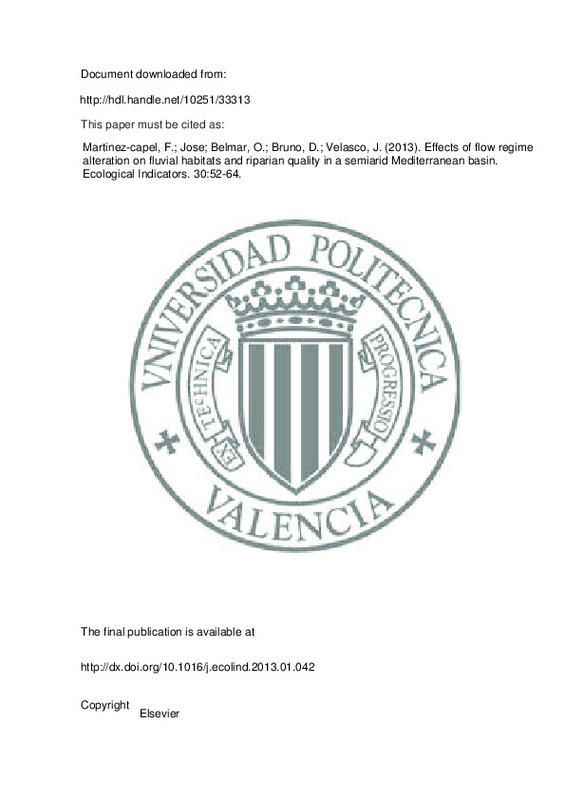|
Resumen:
|
The Segura River Basin is one of the most arid and regulated zones in the Mediterranean as well as Europe that includes four hydrologic river types, according to their natural flow regime: main stem rivers, stable streams, ...[+]
The Segura River Basin is one of the most arid and regulated zones in the Mediterranean as well as Europe that includes four hydrologic river types, according to their natural flow regime: main stem rivers, stable streams, seasonal streams and temporary streams. The relationships between flow regime and fluvial and riparian habitats were studied at reference and hydrologically altered sites for each of the four types. Flow regime alteration was assessed using two procedures: (1) an indirect index, derived from variables associated with the main hydrologic pressures in the basin, and (2) reference and altered flow series analyses using the Indicators of Hydrologic Alteration (IHA) and the Indicators of Hydrologic Alteration in Rivers (IAHRIS). Habitats were characterized using the River Habitat Survey (RHS) and its derived Habitat Quality Assessment (HQA) score, whereas riparian condition was assessed using the Riparian Quality Index (RQI) and an inventory of riparian native/exotic species. Flow stability and magnitude were identified as the main hydrologic drivers of the stream habitats in the Segura Basin. Hydrologic alterations were similar to those described in other Mediterranean arid and semiarid areas where dams have reduced flow magnitude and variability and produced the inversion of seasonal patterns. Additionally, the Segura Basin presented two general trends: an increase in flow torrentiality in main stems and an increase in temporality in seasonal and temporary streams. With the indirect alteration index, main stems presented the highest degree of hydrologic alteration, which resulted in larger channel dimensions and less macrophytes and mesohabitats. However, according to the hydrologic analyses, the seasonal streams presented the greatest alteration, which was supported by the numerous changes in habitat features. These changes were associated with a larger proportion of uniform banktop vegetation as well as reduced riparian native plant richness and mesohabitat density. Both stream types presented consequent reductions in habitat and riparian quality as the degree of alteration increased. However, stable streams, those least impacted in the basin, and temporary streams, which are subject to great hydrologic stress in reference conditions, showed fewer changes in physical habitat due to hydrologic alteration. This study clarifies the relationships between hydrologic regime and physical habitat in Mediterranean basins. The hydrologic and habitat indicators that respond to human pressures and the thresholds that imply relevant changes in habitat and riparian quality presented here will play a fundamental role in the use of holistic frameworks when developing environmental flows on a regional scale
[-]
|
|
Agradecimientos:
|
We wish to thank the University of Murcia for the predoctoral grant to Oscar Belmar and the Ministry for Education, Culture and Sport for the predoctoral grant to Daniel Bruno. We also thank Jose Antonio Carbonell and ...[+]
We wish to thank the University of Murcia for the predoctoral grant to Oscar Belmar and the Ministry for Education, Culture and Sport for the predoctoral grant to Daniel Bruno. We also thank Jose Antonio Carbonell and Simone Guareschi for their support during the fieldwork. Finally, we are also grateful to Melissa Crim and Javier Lloret for double-checking the English.
[-]
|







![[Cerrado]](/themes/UPV/images/candado.png)


